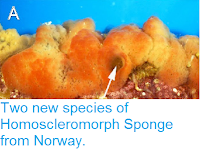Tropical and subtropical reefs are noted for their high biodiversity, particularly on their Coral-dominated shallower parts, where photosynthesis is possible, and which are therefore referred to as the ‘photic zone’. Below this photic zone lies an area where some light is present, but not enough to allow much photosynthesis. In this area, known as the mesophotic zone, Sponges, Porifera, are the dominant reef animals, both in terms of number of species and number of individuals. To date a total of 241 Sponge species have been described from the mesophotic zone of the Caribbean, including 141 from the Greater Antilles (Cuba, Jamaica, Puerto Rico and the Cayman Islands). However, a recent survey of the reefs around Cuba identified a total of 296 species of Sponge, suggesting the presence of many species which have either not been described to date, or not previously been recorded in the Caribbean.
In a paper published in the journal Zootaxa on 31 August 2018, Linnet Basutil of the Instituto de Ciencias del Mar, María García-Hernámdez of the Centro Nacional de Áreas Protegidas, and Christina Díaz and Shirley Pomponi of the Harbor Branch Oceanographic Institute at Florida Atlantic University, describe two new species of Sponge from the Cuban mesophotic zone, both of which are placed in the Demosponge genus Callyspongia.
The first new species is named Callyspongia pedroi, in honour of Cuban marine biologist Pedro Alcolado, for a lifetime dedicated to studying the Sponges of the Caribbean. This species forms a series of branching ropey tubes 10-14 mm in length and 6-10 mm in diameter, smooth to the touch and pink or light red in colour. Branching on this species is uncommon, and it has no true holdfast, adhering to the substrate wherever it touches. It has a fibrous skeleton with embedded fusiform spicules, this skeleton comprises a primary mesh with gaps 120–425 μm across, made up of fibres 20–40 μm in diameter, with a secondary mesh with gaps of 50–350 μm, with fibres 10–15 μm in diameter. Callyspongia pedroi was found on reefs around most of the cost of Cuba, at depths of 44.4–102.4 m.
Callyspongia pedroi. (a) Specimen in live habit, (b) another specimen in live habit, but not collected, (c)-(d) specimen on deck, (e) microconulose surface, and oval flushed osculum. Basutil et al. (2018).
The second species is named Callyspongia alcoladoi, also in honour of Pedro Alcolado. This species forms branching ropey tubes 20-30 cm in length and 3-8 mm in diameter, smooth to the touch, but with occasional spiny projections up to 4 cm in length, and grey-pink in colour. This species also has no true holdfast, adhering to the substrate wherever it touches, though it branches much more frequently than the previous species. It has many subdermal cavities, 0.25–0.8 mm in diameter, which are visible to the naked eye and a skeleton made up of primary, secondary and tertiary meshes of fibres, with the primary mesh having gaps of 80–250 μm, and fibres 30–150 μm in diameter, the secondary mesh having gaps of 70–210 μm, and fibres 15–30 μm in diameter, and the tertiary mesh having gaps of 30-70 μm, and fibres 8-25 μm in diameter. The species was found on the east wall of Bahía de Cochinos on the south coast of Cuba, and at Punta del Fraile northwest of Punta Maisí on the eastern tip of Cuba, at depths of 51.5–73.4 m.
Callyspongia alcoladoi. (a) Specimen in live habit, (b) another specimen in live habit, but not collected, (c)-(d) specimen on deck, (e) Very smooth surface and round osculum, slightly sunken. Basutil et al. (2018).
See also...
Follow Sciency Thoughts on Facebook.







